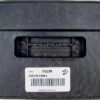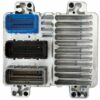Is Your GM Vehicle Stalling, Hesitating, or Refusing to Start?
If your 2009 GMC Acadia, or another compatible GM truck or SUV, is experiencing frustrating fuel delivery problems, a faulty Fuel Pump Control Module (FPCM) is a very likely culprit. This critical component is responsible for precisely managing the voltage sent to your fuel pump, ensuring your engine receives the exact amount of fuel it needs for optimal performance and efficiency. When it fails, it can leave you stranded with an engine that cranks but won’t start, or cause dangerous stalling and hesitation while driving. This replacement 2009 Acadia Fuel Pump Module is the definitive solution to restore your vehicle’s reliability and performance.
From the Diagnostic Bay
We see these GM vehicles come in all the time with a P069E trouble code stored in the computer, complaining of intermittent stalling. The first thing we check is the FPCM. On most of the trucks and SUVs like the Silverado and Tahoe, this module is mounted directly to the driver’s side frame rail, just under the cab. It’s completely exposed to road salt, water, and grime. Over the years, moisture gets past the seals, corrodes the circuit board, and causes all sorts of bizarre fuel pressure issues. Replacing it isn’t just a fix; it’s a necessary service for vehicles in regions with harsh weather. This pre-programmed module makes the job a simple, one-step repair without a trip to the dealership.
Why Choose Our Pre-Programmed FPCM?
The biggest hurdle in replacing a modern vehicle control module is the need for expensive, dealer-specific programming. We eliminate that step entirely. When you purchase this module, you simply provide us with your vehicle’s VIN. Our technicians will then program the unit with the latest GM-certified software specific to your exact vehicle configuration. This ensures that when the part arrives, it is a true plug-and-play solution. You can install it yourself or have your trusted mechanic do the job without needing any special scan tools for setup. It’s ready to work perfectly right out of the box.
Symptoms of a Failing 2009 Acadia Fuel Pump Module
- ✔ Engine cranks but will not start
- ✔ Vehicle stalls unexpectedly, especially under load or when coming to a stop
- ✔ Hesitation or sputtering during acceleration
- ✔ Check Engine Light is on with diagnostic trouble codes (DTCs) such as P069E, P0230, or P0606
- ✔ Reduced engine power or the vehicle entering a “limp mode”
- ✔ A buzzing noise from the fuel pump or no noise at all
- ✔ Inconsistent fuel pressure readings with a mechanical gauge
This module is a direct replacement for a wide range of GM vehicles, ensuring a perfect fit and restored function. It is compatible with multiple original part numbers, including: 13501024, 15213110, 20759945, 20850907, 25785013, 25854536, 25866052, and 25967325. Don’t let a faulty FPCM dictate when and where you can drive. Restore your vehicle’s dependability with this easy, pre-programmed solution.
Frequently Asked Questions
Do I need to get this module programmed by a dealer?
No. This is the primary benefit of our service. We program the module to your vehicle’s specific VIN before we ship it to you. This makes the installation process simple and eliminates the need for expensive dealer tools or additional programming fees.
Where is the FPCM located on my vehicle?
The location varies by model. On most full-size trucks and SUVs (like the Sierra, Silverado, Tahoe, Yukon, Escalade), it’s mounted on the exterior of the driver’s side frame rail. On crossovers (like the Acadia, Enclave, Traverse), it’s often found on a rear crossmember near the fuel tank. A quick search for your specific model will confirm the exact location.
What happens if I forget to provide my VIN?
We cannot ship the module without your Vehicle Identification Number (VIN). The programming is essential for the module to communicate with your vehicle’s other computers. We will contact you after your purchase to remind you, but providing it at checkout will speed up the process.
Is this a common failure on these GM vehicles?
Yes, it is a very common point of failure. The typical mounting location exposes the module to harsh environmental conditions like water, road salt, and debris, which can lead to corrosion and internal electronic failure over time.
What tools are required for installation?
Installation typically requires only basic hand tools, such as a socket and ratchet set to remove the mounting bolts. The most critical step is to disconnect the vehicle’s battery before you begin to ensure your safety and prevent any electrical issues.



